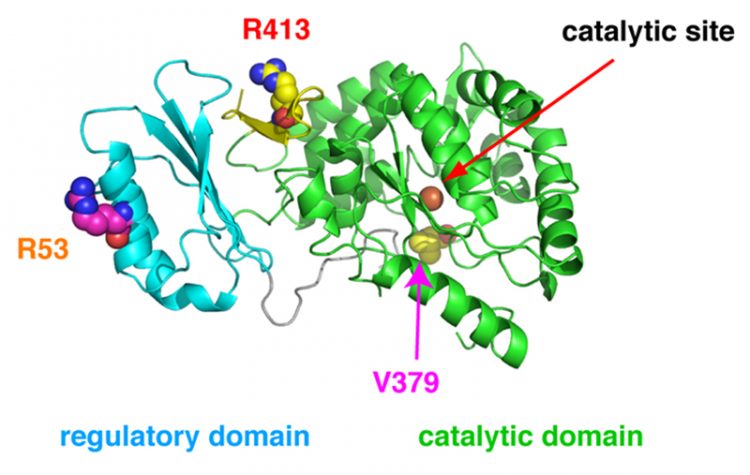Genetic Diversity of Enzymes Alters Metabolic Individuality

The metabolites in plasma were analyzed by NMR spectroscopy. Copyright : Tohoku University
“We discovered genetic variants affecting enzymatic activities in healthy people,” said Dr. Seizo Koshiba. “Our study shows that genetic polymorphisms, structural location of mutation and effect for phenotype correlate with each other in the human population. This implies that metabolic individuality and susceptibility for diseases are possibly resulted from the moderate variants and much more deleterious, but rare, variants.”
In their analyses, researchers found the following results:
– The relationship between structural variants of enzymes and metabolic phenotypes in the human population was surveyed in the association study of metabolite concentrations with whole genome sequence analysis data.
– Five associations between metabolites and gene variants were identified. Four of the gene variants are known to be related to metabolic diseases. The residues substituted by these variants are located in peripheral regions of the catalytic sites or related regulatory domains of enzymes.
– Two people have larger changes of metabolite levels of phenylalanine. They had rare gene variants, which substitute residues located near the catalytic site.
– These data demonstrate that variant frequency, structural location and effect for phenotype correlate with each other in the human population.
ToMMo will study environmental and genetic influence on individual differences of proteomics and metabolomics. ToMMo aims to discover useful biomarkers for disease prevention and early diagnosis through the identification and quantification of metabolites in blood. Such studies can contribute to the advancement of personalized prevention and treatment of diseases, as well as the identification of disease mechanisms and development of new therapeutics.
These findings are based on the analysis of blood samples from 512 healthy people who participated in the Tohoku Medical Megabank Project Community-Based Cohort Study and the Birth and Three-Generation Cohort Study.
Some of the data can be found on ToMMo's website: Japanese Multi Omics Reference Panel (jMorp) (please see the link below).
Contact:
Fuji Nagami
Tohoku Medical Megabank Organization, Tohoku University
Email: f-nagami@med.tohoku.ac.jp
http://www.megabank.tohoku.ac.jp/english/
Associated links
Journal information
Authors: Seizo Koshiba, Ikuko Motoike, Kaname Kojima, Takanori Hasegawa, Matsuyuki Shirota, Tomo Saito, Daisuke Saigusa, Inaho Danjoh, Fumiki Katsuoka, Soichi Ogishima, Yosuke Kawai, Yumi Yamaguchi-Kabata, Miyuki Sakurai, Sachiko Hirano, Junichi Nakata, Hozumi Motohashi, Atsushi Hozawa, Shinichi Kuriyama, Naoko Minegishi, Masao Nagasaki, Takako Takai-Igarashi, Nobuo Fuse, Hideyasu Kiyomoto, Junichi Sugawara, Yoichi Suzuki, Shigeo Kure, Nobuo Yaegashi, Osamu Tanabe, Kengo Kinoshita, Jun Yasuda and Masayuki Yamamoto
Title: The structural origin of metabolic quantitative diversity
Journal: Scientific Reports
DOI: 10.1038/srep31463
Media Contact
All latest news from the category: Life Sciences and Chemistry
Articles and reports from the Life Sciences and chemistry area deal with applied and basic research into modern biology, chemistry and human medicine.
Valuable information can be found on a range of life sciences fields including bacteriology, biochemistry, bionics, bioinformatics, biophysics, biotechnology, genetics, geobotany, human biology, marine biology, microbiology, molecular biology, cellular biology, zoology, bioinorganic chemistry, microchemistry and environmental chemistry.
Newest articles

A universal framework for spatial biology
SpatialData is a freely accessible tool to unify and integrate data from different omics technologies accounting for spatial information, which can provide holistic insights into health and disease. Biological processes…

How complex biological processes arise
A $20 million grant from the U.S. National Science Foundation (NSF) will support the establishment and operation of the National Synthesis Center for Emergence in the Molecular and Cellular Sciences (NCEMS) at…

Airborne single-photon lidar system achieves high-resolution 3D imaging
Compact, low-power system opens doors for photon-efficient drone and satellite-based environmental monitoring and mapping. Researchers have developed a compact and lightweight single-photon airborne lidar system that can acquire high-resolution 3D…





















